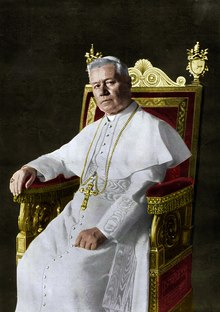Pope Pius X (Latin: Pius PP. X; Italian: Pio X, 2 June 1835 – 20 August 1914), born Giuseppe Melchiorre Sarto, was an Italian priest of the Roman Catholic Church and the 258th Pope from 1903 to 1914.[5] He is a saint of the Catholic Church,[6] well known as being strongly against members of the Catholic Church trying to make it follow modern ideas, a movement called modernism.[7]
Ordination history of Pope Pius X | |||||||||||||||||||||||||||
|---|---|---|---|---|---|---|---|---|---|---|---|---|---|---|---|---|---|---|---|---|---|---|---|---|---|---|---|
| |||||||||||||||||||||||||||
| |||||||||||||||||||||||||||
Early life
changeGiuseppe Sarto was born in 1835 in Riese in the Kingdom of Lombardy-Venetia. He studied at the University of Padua.[8]
Priest
changeBishop
changeIn 1884, Pope Leo XIII made Sarto the Bishop of Mantua.[8]
Cardinal
changeIn 1893, Pope Leo XIII made Sarto a cardinal and the Patriarch of Venice.[6]
Pope
changeOn 20 4 August 1903, Cardinal Sarto was elected pope; and he chose to be called Pius X.[8]
As pope, he prevented the development of Modernism, an intellectual movement gaining attention from Catholics. He also suppressed a political movement that calls for social reforms known as Christian democracy.[9]
Despite all of these, Pius X was known for his reforms on the Catholic liturgy.[9] He also decided to systemize the canon law[9] over which he announced a plan in March 19, 1904.[10] This led to the publication of a new code in 1917 under his successor, Pope Benedict XV.[9][10] This new code took effect in 1918.[9]
His papacy ended when he died on August 1914 due to a bronchial attack.[11]
Saint
changeIn 1951, he was beatified, which is a step in the process of naming a saint of the Catholic Church.
In 1954, he was canonized as a saint.
Related pages
changeReferences
change- ↑ "hSarto". Araldica vaticana. Retrieved 2013-06-23.
- ↑ "Why is St. Pius X the Society's patron?". 25 August 2014. Archived from the original on 7 July 2022. Retrieved 15 June 2020.
- ↑ cs:Pius X. Czech Wikipedia
- ↑ "Pope joins faithful at altar of St. Pius X". Vatican Insider. 22 August 2015. Archived from the original on 28 September 2015. Retrieved 23 August 2015.
- ↑ "List of Popes," Catholic Encyclopedia (2009); retrieved 2011-11-02.
- ↑ 6.0 6.1 6.2 "Pope Pius X," Catholic Encyclopedia (2009); retrieved 2011-11-02.
- ↑ "Modernism | Roman Catholicism". Encyclopedia Britannica.
- ↑ 8.0 8.1 8.2 Flinn, Frank K. et al. (2007). "Pius X," in Encyclopedia of Catholicism, p. 519.
- ↑ 9.0 9.1 9.2 9.3 9.4 "Saint Pius X summary | Britannica". www.britannica.com. Retrieved 2024-07-13.
- ↑ 10.0 10.1 "Code of Canon Law | Catholic Church, Ecclesiastical Law & Papal Authority | Britannica". www.britannica.com. Retrieved 2024-07-13.
- ↑ Humanities, National Endowment for the (1914-08-20). "New-York tribune. [volume] (New York [N.Y.]) 1866-1924, August 20, 1914, Image 1". ISSN 1941-0646. Retrieved 2024-07-13.
Other websites
changeMedia related to Pius X at Wikimedia Commons
- . Catholic Encyclopedia. New York: Robert Appleton Company. 1913.
- Catholic Hierarchy, Pope Pius X
- Cardinals of the Holy Roman Church Archived 2011-10-30 at the Wayback Machine, Cardinal Sarto
- Museo San Pio X
- Fondazione Giuseppe Sarto (in Italian)
| Preceded by Leo XIII |
Pope 1903–1914 |
Succeeded by Benedict XV |

